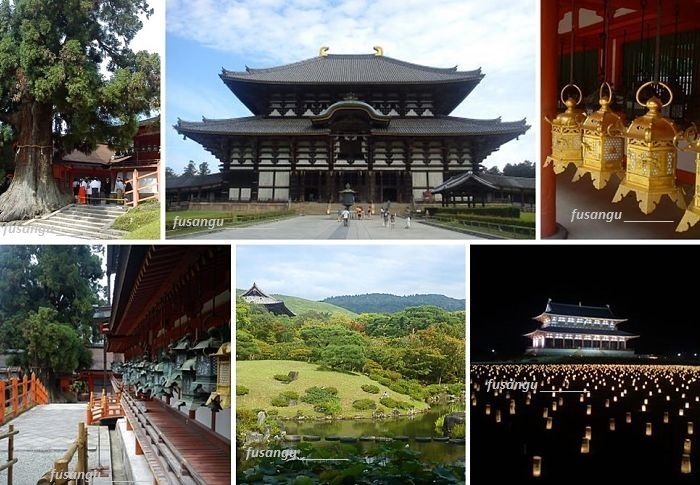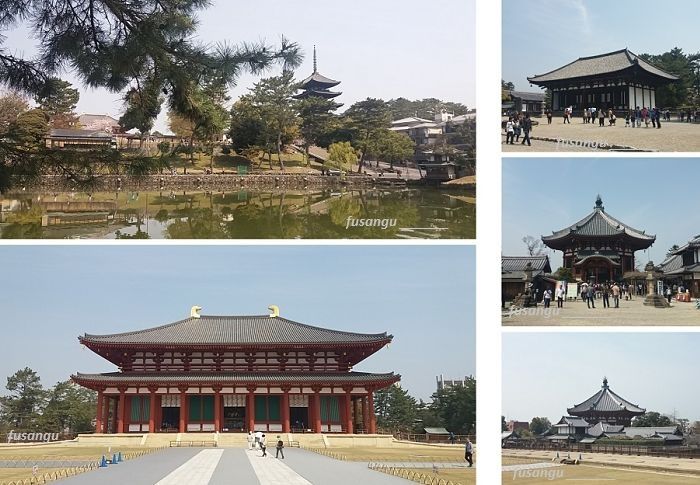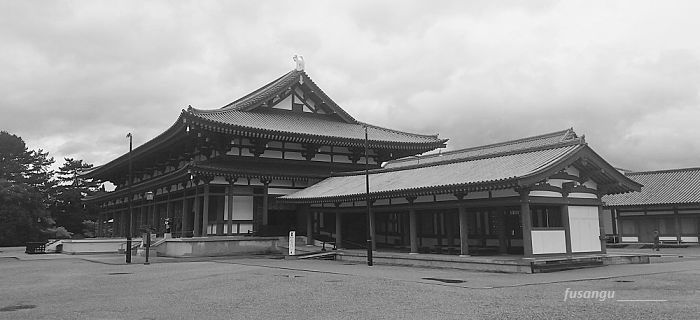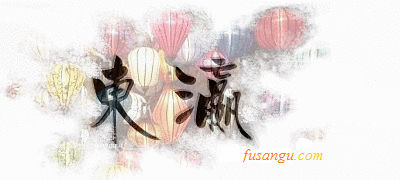
A one-day visit to Nara, especially if arranged as a day trip from Osaka or Kyoto, has to be organised very carefully because time is very limited and there are many places to visit and things to see and do.
The most reasonable choice is to limit the visit within the Park of Nara area. This is a wonderful natural scenery home to a number of gardens, ancient shrines and temples.
One day is very little time to visit Nara. You will definitely enjoy visiting Nara in one day and with a careful organisation you will see many beautiful places of historical and artistic importance but you should at least be aware of the fact that such a short visit will not give you a clear picture of what this city represented in Japan.
In this page we provide information and suggestions on how to organise a one-day visit to Nara. The article is the result of two visits in different periods of the year. In our choices we have a clear idea of what places are to be visited in a one-day your and what should be reserved to a longer stay.
Nara in one day: places to visit, what to see
Nara is home to many important temples and shrines which provide insight into its glorious past, when the city was a capital modelled upon the magnificent Tang China’s capital, Chang’An.
A one-day tour is often limited to the Nara Park area. This is a wonderful setting where deer (Nihonshika) freely wander among ponds, old buildings, shrines, temples. Many of these are vestiges of outstanding beauty.
What you will not be able to see, unless you plan a 2-day visit, are the old temples and archaeological sites in the Nishinokyo area. These are large scale sites where you will get images of the old capital, its relation to China, its importance in the birth of Japanese Buddhism.
Needless to say, you will enjoy visiting Nara in 2 days more if you have already been to China.

Visiting Nara in 1 day: suggested itinerary
Having only one day available, it is reasonable to limit the scope of the visit to the area of Nara Park.
Itinerary: Kofuku-Ji, Isui-En, Todai-Ji, Kasuga Taisha
The following is the classic one-day Nara itinerary. If you visit the city for the first time, this is the ideal programme. Additions are possible, because the area is very small, getting around by bus or on foot is easy and pleasant.
We suggest you keep a slow pace though. Nara is a place where less is more, where you want to allow yourself time to feel the atmosphere of the past, complement what you see with what you feel and can imagine.
A pseudo-circular itinerary starts from Nara Station and goes through Kofuku-Ji temple, Isui-En garden, Todai-Ji temple and its surrounding and Kasuga Shrine.
|
Itinerary |
8:30 – 9:30
Kofuku-Ji
Kofuku-Ji is an ancient temple situated at the eastern side of Nara Park. It was founded by the Fujiwara family when Nara became Japan’s capital and it has since had a fundamental role in the diffusion of Buddhism in the country.
At the height of the city’s development it comprised over 100 buildings. Today few structure survive. Among them are four buildings whose historical and artistic value is so exceptional that they are classified as National Treasure.
The large central Main Hall is a recent reconstruction. It gives images of the scale and majesty of this fundamental religious site.
The five-storey pagoda is the second tallest pagoda in Japan. Its gentle shape stands out when you view Sarusawa Pond from its southern shore.
A significant part of the collection of relics of the temple is on display in Kofukuji National Treasure Museum. If you are fond of sacred art, do not miss out on a visit.
A non-shallow visit requires no less than 2 hours.
Address: Noborioji-cho 48
Opening hours: 9:00-17:00, every day
Entrance: Central Main Hall, 500 yen; Eastern Main Hall, 300 yen; Treasure Hall, 700 yen
9:30 – 10:00
Nara Park
Walk through Nara Park
10:00 – 11:00
Isui-En
Regarded as Nara’s most beautiful garden, Isui-En is a little gem secluded from the outside world, one of those places where you will like to experience a different perception of time.
The garden lies between Todai-Ji and Kofuku-Ji. Built for an affluent merchant as a villa, it comprises living quarters and a tea house. A large strolling garden challenges your spirit of observation with a fascinating sequence of views of exceptional beauty.
The most beautiful view can be had from the tea house. By use of shakkei technique, the gate of Todai-Ji and the ridge of Wakakusayama are included in the scene.
In the harmonious composition every element is meant to differently contribute in the four seasons. This attention, amounting to cherishing of Nature, is a firm tenet of traditional Japanese art.
A small collection of pottery is found at Neiraku Museum.
A visit should last around an hour.
You can then proceed to visit the adjacent Yoshiki-En, another beautiful garden (the entrance is free of charge).
Address: Suimon-cho 74
Opening hours: 9:30-16:00, except Tuesdays
Entrance: 650 yen
11:00 – 12:00
Todai-Ji
If you have visited China before you will definitely recall images of your journey once you see Todai-Ji.
The imposing temple is testimony to the extent to which Tang China influenced the Japanese culture.
The solemn path leading to it goes through the old Nandaimon gate (the one whose roof appears behind the scenery at Isui-En garden).
The wooden gate is guarded by the fierce-looking protective Nio figures.
The Daibutsuden, the main hall of the temple, is one of the largest wooden structures in the world. Originally it was bigger than the current one, a reconstruction.
Inside is the impressive statue of Buddha (Daibutsu). Cast in bronze, it weighs more than 400 tons and it was gilded. The whole nation contributed to this exceptional work of art.
The spacious grounds comprise many buildings, gardens and a storehouse, the Shoso-In.
Nigatsu-Do, a temple overlooking Nara on the slopes of Mount Wakakusa, is part of Todai-Ji. The area around it is particularly scenic and deserves a lengthy stroll.
Address: Nara, Zoshi-cho 1
Opening hours: 8:00-16:30
Entrance: 500 yen
12:00 – 15:00
Nigatsu-Do and Wakakusayama
As anticipated, the surroundings of Todai-Ji are well worth a visit. As you walk toward Kasuga Taisha make sure to pass through Nigatsu-Do
There are a few places where you can have a quick lunch.
15:00 – 16:00
Kasuga Taisha
One of Japan’s most sacred religious sites, Kasuga Taisha is an ancient shrine nestled amid an atmospheric old forest.
The site comprises numerous auxiliary shrines devoted to numerous deities.
The iconic lanterns, in many shapes and colours, in stone and bronze, are lined both inside and outside the shrine. They mark the sando, the entrance path, which is a journey of the spirit in itself.
Buildings in the distinct bright vermilion colour are the most notable and finest examples of Kasuga-zukuri architectural style. They incorporate elements of China’s sacred architecture, such as the gently sloping roofs. Deer and wisteria (appearing in the crest of the Fujiwara family) are recurrent in the ornamental motifs.
Inside the grounds stand large cypress trees,some of them marked with a shimenawa.
There is a clear relation of harmony between the shrine and the surrounding environment and you might spend hours looking for the best views.
Over 200 species of plants are in the beautiful Shinen Manyo Botanical Garden.
Do not forget to visit the sacred Kasugayama Primeval Forest, and Wakamiya shrine
Best time to visit Kasuga Taisha is autumn. Wisteria blossom, in early May, is another amazing sight. In mid-August during Mandoro matsuri lanterns are lit.
Address: Nara, Kasugano-cho 160
Opening hours: shrine, 6:00-17:30; Botanic Garden, 9:00-16:30
Entrance: shrine, 500 yen; Botanic Garden, 500 yen
16:00 – 17:00
Nara Park, Umiki-Do
Walk toward Nara Station or Nara-machi
One day and a half: how to change the itinerary
Choosing to stay in Nara instead of visiting it on a day trip from Kyoto and Osaka makes the experience much more enjoyable.
If you do so, you can enjoy the city outside of the tourist bubble and visit places in complete tranquillity. Furthermore, you can also add one or two destinations, such as:
-
Horyu-Ji, one of the most ancient temples of the nation, it is linked to the early history of the introduction of Buddhism in Japan. Its spacious grounds house some of the olderst wooden buildings in the world. Some of the invaluable works of art are on display in the museum;
-
Heijo Palace archaeological site, a large area with many vestiges of the ancient capital. Few structures have been reconstructed;
-
Yakushi-Ji and Toshodai-Ji, among Nara’s most important and culturally significant temples. They play an important role in the history of Japan. Toshodai-Ji is the burial site of Ganjin, a Chinese monk who contributed to the diffusion of Buddhism in Japan.
If you want to visit all these sites you need at least two days.

This itinerary is ideally part of a 10-day journey. Details in the following page:

